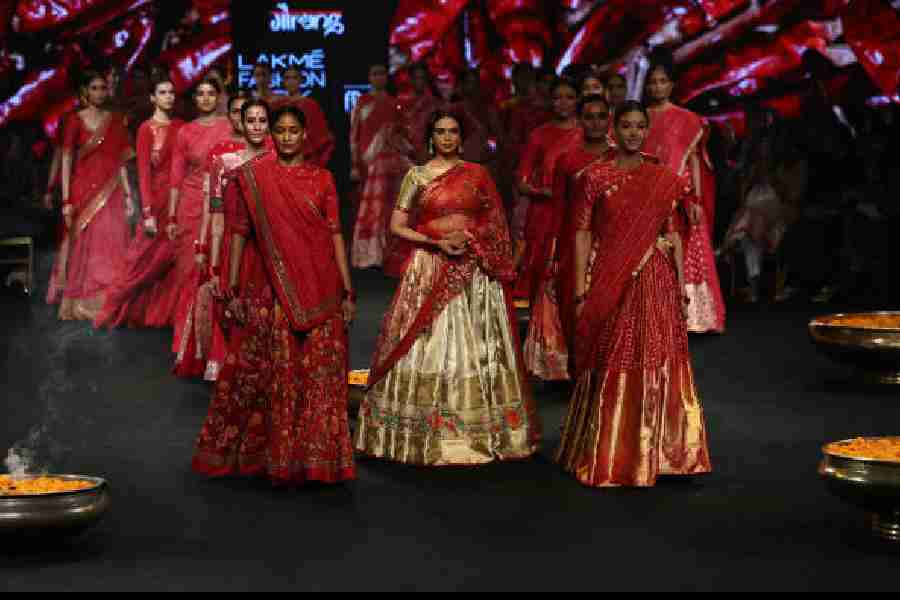He keeps coming back to Calcutta and has been working with the Bengal cluster of weavers since 2005-06. And, on his recent trip, he had already tucked into Malai Gilori and Mishti Doi by the time t2 caught up with him at the relaunch of the revamped fashion stop Smart! on Loudon Street. Designer Gaurang Shah. One who doesn’t mince words. In a chat with t2, Gaurang shared how he has been coping since the pandemic hit us, how handlooms should be a part of our lives and how going ahead, it’s just “work, work and work”.
What about Calcutta attracts you the most?
I love the beauty of the women and how they dress, in saris, with the big bindi. That’s what I love about the Bengalis. And, the sweets! (Laughs)
You have been working with the Bengal cluster for so many years. What are the differences you see post-pandemic?
Before (the pandemic) we used to do a lot of work. Then during Covid, we had to stop because we couldn’t pay and there was no money coming in. We also lost some of the weavers to Covid. Post-Covid, when things came back to normal, we started work again. Some of the weavers left weaving and took up some other jobs. They need money every day. Now, slowly they are coming back. It’ll take some time to come back to what it was pre-Covid. The kind of things I do, the most intricate ones which take lots of time... each sari takes about a year or a year-and-a-half years to weave. I need at least two people on the loom. If there is a master weaver, I’ll need a helper too. So, we are running a few looms right now.
My looms in Paithan take a lot of time. Each sari takes about three years to weave. Also, my looms in Varanasi are taking time because I don’t have helpers to help there.
How are you tackling these challenges?
We are in shortage of saris right now. There is demand, but we don’t have the saris. So, we are exploring other things. We have started doing the traditional embroidery like petit point and Parsi gara. That is also a long process. One petit point borders take two-and-a-half-years to make. I have started working in Kashmir where they weave Kani shawls in wool and pashmina. So, I am doing Kani in khadi. I have started with three pieces. So, a minimum of two years for each piece.
Before I was only weaving in India. Now I have expanded. I am weaving my ikats in Cambodia and Thailand. I am going to start working in Uzbekistan. They weave only stoles, shawls and dupattas. I am getting them into weaving saris. I am doing a whole range of natural dyes in Patan. In khadi Jamdani, I am using Mughal architectural designs. First, I used to do only florals and Tree of Life. So, I am doing something unusual which is much more intricate. Also, generally if you want to sustain, you need to come up with new things.
So, even for someone like you who is never in a rush, it is challenging...
It is (smiles). I have loads of designs ready with me, but I don’t have weavers. When the first wave came, we didn’t know what was going to happen in the future. The second wave went into the villages. I lost master weavers in Paithan and Varanasi. For the new weavers to come up to that level, it will take time. See, it took me 23 years to come to this level. So, it’s like coming back to zero now.
You had to get into e-commerce during the pandemic...
I had to and in the beginning when people couldn’t come out of the house, it worked, but then I shut it off within a year too. I am in luxury and up to a certain range it sells on e-commerce. If you are buying a sari that would cost you a few lakhs, I prefer that you come and see it and enjoy it and then buy it. We started in August 2020 and then I shut it off by August 2021. My customers want to come to the store and try 10-15 saris, drape it and I will explain. They want an experience. We don’t do video calls or WhatsApp calls because it doesn’t do justice to the designs and colours.
Is luxury really booming?
It is. It has become about occasionwear. The heavy saris and the rich weaves that we do, they’ll wear it to a wedding or a party and then they want something exclusive, and they are ready to pay for it. I have politicians, industrialists and working women who are buying. I have customers worldwide and I know them and what they are going to like.
Over the last two decades, what have the general challenges of working with the handwoven been like?
Earlier, it was setting up the loom and convincing the weavers to weave this, because my saris are extensive with intricate designs. Earlier, they would weave one sari in two-three months. Now, each sari is going to take two-two-a-half-years. So, it was about gaining their confidence that... pura paisa aayega. I give them a salary every month.
Now, it is about getting more weavers.... Sometimes they get bored (because of the long process). I try to explain to them that each year I try to do something different for my client. For me, every show has to go up a level higher. That is why this year I am not doing any shows.
Do you like the fact that heritage has become a fad now?
It is a fad, but it is good because at least people are talking about it. Thoda knowledge toh badh raha hai sabka. Someday these people will start buying too.
How do you deal with creative blocks?
I travel a lot and with that all the blocks go away. I never get those blocks. I visualise everything and explain it to my team. I can see my whole show in front of me. For me, it’s the whole package. The music, the ambience and the models. It’s teamwork.
You mentioned you often come to Calcutta. Any other city you like going to?
Ahmedabad understands textiles. I like going there.
What is your message for all the budding designers?
I would tell them to work with handlooms. There is so much heritage here, why copy the West? Every few kilometres you have something different. Sari is one of the most beautiful garments. Thousands of students come out of design schools. Where are they? Designers like Tarun Tahiliani and Sabyasachi are still at the top. No one has come up to even one per cent of that level.

Kirron Kher: She loves everything... our khadis, Jamdanis, Kanjeevarams....
Vidya Balan: She is more of a Kanjeevaram person. She is down-to-earth. Once she was in Hyderabad, she called me to see weaving. I took her to a village, three hours from Hyderabad, and she sat on the loom and learnt it
